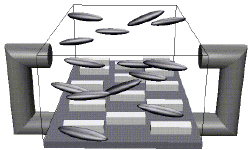Herding Molecules

Growing ordered films can be a lot like trying to gather a flock of ornery sheep. But a group of researchers has now found a sheep dog: They successfully persuaded liquid crystals to herd molecules into organized solid films. As they describe in the 20 March PRL, the team dissolved organic molecules in a liquid crystal solution and used magnetic fields to communicate with the liquid crystal, which corralled the molecules into films with unprecedented uniformity. Such highly uniform molecular solids may be useful for a range of cutting-edge electronic devices that use carbon-based molecules instead of silicon.
Creating these promising materials reliably is difficult. Researchers have already honed their skills at producing more traditional solid materials, like silicon, that grow atom by atom, but they have not yet mastered the fabrication of solids that grow molecule by molecule. The growth of most organic molecular films involves extreme (and expensive) environments, usually including high temperatures and an ultrahigh vacuum. And after all that trouble, the end product is usually not impressive, with the film molecules pointing in various directions.
The new technique–developed by David Patrick and his colleagues at Western Washington University in Bellingham–addresses the problems of low quality and expensive growing conditions. For each organic molecule they worked with, the team first dissolved the organic compound in a heated (100 degrees C) liquid crystal solution and put a graphite surface at the bottom of the container. They then turned on a magnetic field, which aligned the liquid crystal molecules along the field, and began cooling the solution. The lowered temperature forced the organic molecules to stick to the graphite substrate, but not before feeling the strong orienting influence of the liquid crystal molecules, which were not attracted to the graphite.
The organic molecules formed films one molecule deep on the 1 $\textrm{cm}^{2} substrates and exhibited a uniform alignment to within an angle of 10 degrees. The orientation is permanent, even with the field and liquid crystal removed. Patrick says conventional methods give such poor uniformity that no one has seriously measured the degree of alignment before. “There’s no standard for comparison here.” The films Patrick and his colleagues made cannot be used for electronics applications, but they demonstrate the alignment power of liquid crystals.
Michael Wolf, of the University of British Columbia in Vancouver, praises the work. “It’s definitely an advance in the field of preparing thin molecular films,” he says. “Certainly there are many applications” for organic semiconductors, such as improved display technology, but Wolf cautions that many years of development are needed before the technique and any such devices are commercialized. Patrick and his colleagues now plan to take the next step and grow aligned films of molecular semiconducting materials. A uniform orientation would improve their electronic properties and bring them closer to becoming the microchip material of the future.
–Brandon Brown
Brandon Brown is an Assistant Professor of Physics at the University of San Francisco and a freelance science writer.


